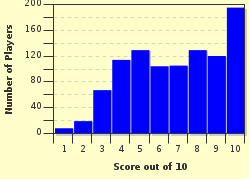Quiz Answer Key and Fun Facts
1. Which famous writer once said "He was a bold man, that first eat an oyster"?
2. The city of Colchester in Essex, England, hosts an Oyster Festival each October. The local people are adamant that "Colchester Natives" are the best oysters in the world. Which King of England granted Colchester the fishing rights to its oyster beds, under the terms of a Royal Charter, way back in 1189?
3. One fate that may befall an oyster is when a Urosalpinx cinerea uses its "sandpaper like radula" to make a hole in the shell, then sucks out the live oyster and eats it! What type of creature is a Urosalpinx cinerea?
4. For centuries, the Sulu Archipelago was renowned for the quality of the pearls found there; although they were all technically the property of the ruler of the country, some found their way to Europe where they sold for huge sums of money. Which modern day country is the Sulu Archipelago part of?
5. During the nineteenth century, oyster pirates were commonplace, particularly around the San Francisco Bay area of the United States. What was an oyster pirate?
6. Which scientific Family do true oysters belong to?
7. Other creatures, apart from oysters, can make pearls.
8. In 2009, a device called Oyster was placed in the sea just off the coast of one of the Orkney Islands in northern Scotland. What is the purpose of Oyster?
9. In London, what would you use an Oyster Card for?
10. According to Samuel Butler, in his "Dyet's Dry Dinner" of 1599, when should one not eat an oyster?
Source: Author
Rowena8482
This quiz was reviewed by FunTrivia editor
Nannanut before going online.
Any errors found in FunTrivia content are routinely corrected through our feedback system.

